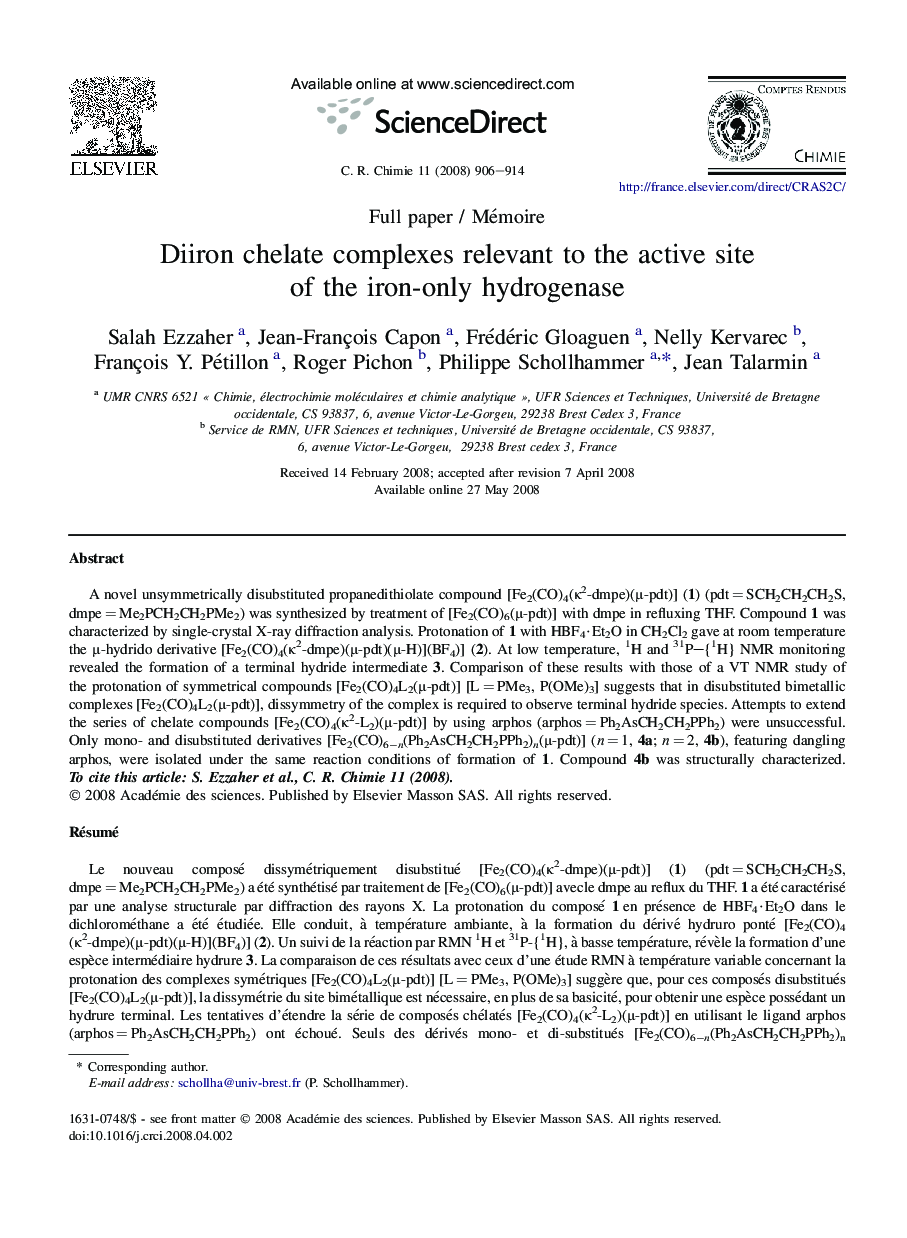| کد مقاله | کد نشریه | سال انتشار | مقاله انگلیسی | نسخه تمام متن |
|---|---|---|---|---|
| 171489 | 458461 | 2008 | 9 صفحه PDF | دانلود رایگان |

A novel unsymmetrically disubstituted propanedithiolate compound [Fe2(CO)4(κ2-dmpe)(μ-pdt)] (1) (pdt = SCH2CH2CH2S, dmpe = Me2PCH2CH2PMe2) was synthesized by treatment of [Fe2(CO)6(μ-pdt)] with dmpe in refluxing THF. Compound 1 was characterized by single-crystal X-ray diffraction analysis. Protonation of 1 with HBF4·Et2O in CH2Cl2 gave at room temperature the μ-hydrido derivative [Fe2(CO)4(κ2-dmpe)(μ-pdt)(μ-H)](BF4)] (2). At low temperature, 1H and 31P–{1H} NMR monitoring revealed the formation of a terminal hydride intermediate 3. Comparison of these results with those of a VT NMR study of the protonation of symmetrical compounds [Fe2(CO)4L2(μ-pdt)] [L = PMe3, P(OMe)3] suggests that in disubstituted bimetallic complexes [Fe2(CO)4L2(μ-pdt)], dissymmetry of the complex is required to observe terminal hydride species. Attempts to extend the series of chelate compounds [Fe2(CO)4(κ2-L2)(μ-pdt)] by using arphos (arphos = Ph2AsCH2CH2PPh2) were unsuccessful. Only mono- and disubstituted derivatives [Fe2(CO)6−n(Ph2AsCH2CH2PPh2)n(μ-pdt)] (n = 1, 4a; n = 2, 4b), featuring dangling arphos, were isolated under the same reaction conditions of formation of 1. Compound 4b was structurally characterized.
RésuméLe nouveau composé dissymétriquement disubstitué [Fe2(CO)4(κ2-dmpe)(μ-pdt)] (1) (pdt = SCH2CH2CH2S, dmpe = Me2PCH2CH2PMe2) a été synthétisé par traitement de [Fe2(CO)6(μ-pdt)] avecle dmpe au reflux du THF. 1 a été caractérisé par une analyse structurale par diffraction des rayons X. La protonation du composé 1 en présence de HBF4·Et2O dans le dichlorométhane a été étudiée. Elle conduit, à température ambiante, à la formation du dérivé hydruro ponté [Fe2(CO)4(κ2-dmpe)(μ-pdt)(μ-H)](BF4)] (2). Un suivi de la réaction par RMN 1H et 31P-{1H}, à basse température, révèle la formation d'une espèce intermédiaire hydrure 3. La comparaison de ces résultats avec ceux d'une étude RMN à température variable concernant la protonation des complexes symétriques [Fe2(CO)4L2(μ-pdt)] [L = PMe3, P(OMe)3] suggère que, pour ces composés disubstitués [Fe2(CO)4L2(μ-pdt)], la dissymétrie du site bimétallique est nécessaire, en plus de sa basicité, pour obtenir une espèce possédant un hydrure terminal. Les tentatives d'étendre la série de composés chélatés [Fe2(CO)4(κ2-L2)(μ-pdt)] en utilisant le ligand arphos (arphos = Ph2AsCH2CH2PPh2) ont échoué. Seuls des dérivés mono- et di-substitués [Fe2(CO)6−n(Ph2AsCH2CH2PPh2)n(μ-pdt)] (n = 1, 4a ; n = 2, 4b) ont été isolés dans les mêmes conditions expérimentales que pour la formation de 1. 4b a été caractérisé par une analyse structurale par diffraction des rayons X.
Journal: Comptes Rendus Chimie - Volume 11, Issue 8, August 2008, Pages 906–914